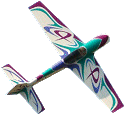How to Noise Test a Model Aircraft
(The BMFA way)
How to noise test a fixed wing model aircraft
- Measurements should be taken in the open air and away from
noise reflecting surfaces such as buildings, cars, and hedges.
- The wind speed should not be over 3 metres per second (force
2).
- Measure a distance of 7 meters and place marks on the ground.
If there are existing marks, double check to make sure they have
not been moved.
- Make sure that the foam wind muffler is fitted to the sound
meter, this is VERY IMPORTANT.
- Set the sound meter switches as follows.
- Set the "function" switch to "A weighting"(this
is the closest representation to what a human can hear
- Set the "response" switch to "S" (Slow).
- Turn on the meter and select the "range" to "Lo".
- For safety, a third party who should stand on the opposite
side of the tester to the noise meter should hold the transmitter.
Failing this the person holding the noise meter should have control
of the transmitter.
- The engine in the model should be tuned to obtain maximum RPM
at full throttle.
- The model should be upwind of the noise meter.
- The model should be held between 1 and 2 meters off the ground
and as far from the person holding it as possible, this is due
to reflected noise.
- The sound metre should be 1.2 meters off the ground (approx
shoulder height) and out to one side at arms length this is to
reduce the amount of reflected noise.
- Holding the engine over the marker at all times, the testing
of the model can now commence as follows…
- model pointing directly at the meter
- model pointing 90° to left of meter
- model pointing directly away from the meter
- model pointing 90° to right of meter
- The highest reading should be used.
BMFA ADVICE
ON THE NOISE TEST
The noise testing procedure noted in the DoE (Department of the
Environment) noise code above should be followed carefully but to
get the best results it is strongly recommended that you should
take special note of the following:
Make sure that no noise reflecting surfaces are near the test site.
This means not just buildings but cars, concrete, models, model
boxes and even hard packed earth. Do the test over grass.
Do not take measurements when there is any appreciable background
noise. Traffic on a nearby road, other models flying or being readied
for flight and even people talking near the meter can affect the
readings.
Wind blowing across the microphone has a big effect on readings.
Do not test on breezy days and when you do test, use a microphone
windshield.
Make sure that the actual microphone is over the end of the seven
metre tape, not your hand or the centre of the meter.
Think carefully about the four test positions of the model at the
other end of the tape. As a suggestion, for the sideways-on readings
put the fuselage on the seven metre mark, for the nose-on reading
put the propeller over the mark and for the tail-on reading line
the trailing edge of the wing up with it.
|
|

